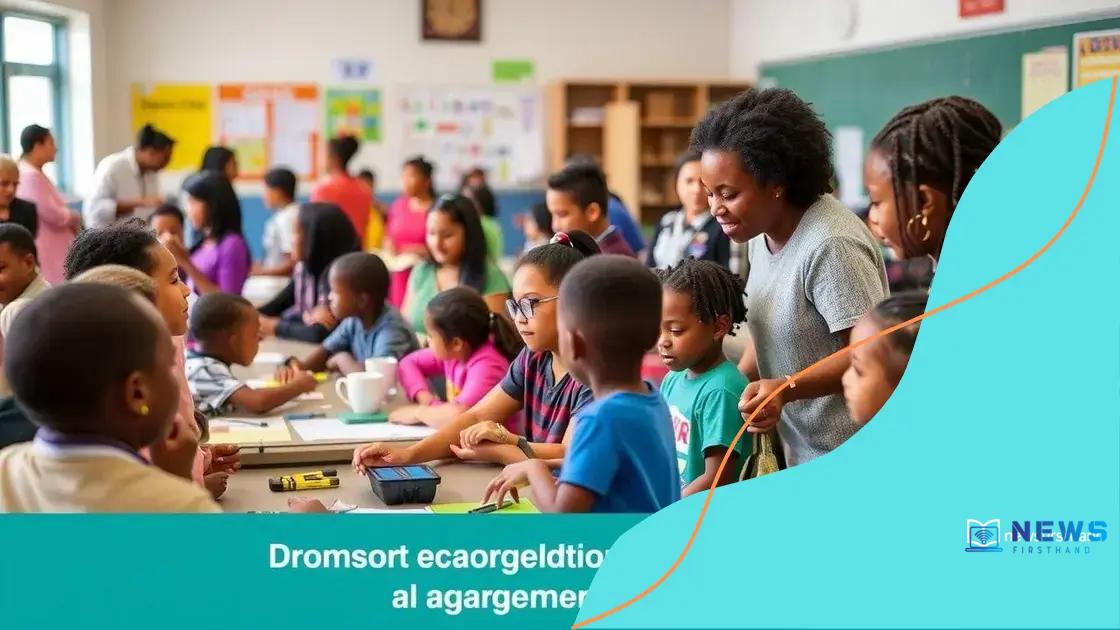Strategic initiatives to reduce high school dropout rates

Strategic initiatives to reduce high school dropout rates focus on mentorship, community involvement, tailored programs, and innovative engagement strategies to support students academically and emotionally.
Strategic initiatives to reduce high school dropout rates play a vital role in ensuring students stay engaged and complete their education. Have you ever wondered what effective strategies can truly make a difference in this area? In this article, we’ll explore various approaches that schools and communities can implement to help students succeed.
Understanding the root causes of dropout rates
Understanding the root causes of dropout rates is essential for developing effective strategies. A detailed look reveals that multiple factors, including personal circumstances and school environment, influence a student’s decision to leave school. By identifying these causes, schools can take action to address them.
Key Factors Contributing to Dropout Rates
Several critical elements play a role in why students drop out. These include:
- Poverty: Many students face economic challenges that can hinder their ability to continue schooling.
- Family Issues: Factors such as single-parent households or lack of support can significantly affect a student’s dedication.
- Academic Struggles: Students struggling with coursework may feel overwhelmed and consider dropping out.
Additionally, a negative school climate can also deter students. Schools that lack proper resources, support, or a positive atmosphere can contribute to feelings of isolation.
Importance of Engagement
Engagement is vital for students. When students feel connected to their school community, they are less likely to leave. Positive relationships with teachers and peers can foster a sense of belonging. Implementing programs focused on mentorship and student involvement can make a significant difference.
Moreover, identifying at-risk students early allows schools to provide the necessary support. Strategies might include counseling, tailored academic programs, and extracurricular activities aimed at re-engaging these individuals.
Ultimately, recognizing the root causes of dropout rates helps schools develop targeted solutions. By focusing not only on academic performance but also on personal and environmental factors, we can create an environment where every student has the opportunity to succeed.
Successful programs and their key features
Successful programs aimed at reducing dropout rates share common features that make them effective. These initiatives not only address the academic needs of students but also focus on their emotional and social well-being. By integrating support systems, schools can create a more welcoming environment.
Key Features of Successful Programs
Some essential components of these programs include:
- Supportive Mentorship: Pairing students with mentors who guide and encourage them fosters a sense of belonging.
- Tailored Academic Support: Providing tutoring and individualized instruction helps students keep up with their studies.
- Parental Involvement: Engaging families can enhance student motivation and accountability.
Programs that successfully engage students often include activities that resonate with their interests. For instance, integration of vocational training alongside academic learning helps students see the real-world applications of their education. This not only enhances engagement but also prepares them for future careers.
Community Collaboration
Collaboration with community organizations plays a significant role in supporting students. When schools partner with local businesses and nonprofits, they can provide resources such as job shadowing, internships, and life skills training. These elements not only bolster students’ practical skills but also strengthen their commitment to education.
Moreover, such programs often incorporate flexible learning environments. By offering alternative school settings or online courses, educators can accommodate different learning styles and paces, making education accessible to everyone. This can lead to increased student satisfaction and retention.
Ultimately, when schools implement programs with these key features, they address the multifaceted reasons behind dropout rates. The focus on mentorship, community collaboration, and tailored support helps students feel valued and understood, encouraging them to stay in school and achieve their educational goals.
Community involvement in student retention

Community involvement plays a crucial role in student retention and is essential for fostering a supportive learning environment. When schools collaborate with local organizations and families, they create a network that assists students both academically and emotionally. This collaboration can lead to better outcomes and a lower dropout rate.
Benefits of Community Involvement
Engaging the community brings numerous advantages to schools. Some key benefits include:
- Enhanced Resources: Partnerships often provide additional resources that schools might lack, such as funding, materials, and volunteers.
- Broadened Support Networks: Students gain access to mentoring programs, counseling services, and career advice through community connections.
- A Sense of Belonging: When students see their community invested in their education, they feel more connected and valued.
Additionally, community events can engage students outside of the classroom. Activities such as workshops, sports leagues, and arts programs allow students to explore interests and develop skills. This exposure can boost motivation, making students less likely to disengage from their education.
Strategies for Effective Involvement
To foster strong community involvement, schools can implement various strategies. One effective approach is to encourage family engagement through regular communication. Informing parents about school events, academic performances, and volunteering opportunities helps create a supportive network. Schools can also host community forums where parents and local organizations can discuss issues and collaborate effectively.
Furthermore, schools should seek feedback from students and families to understand their needs better. This insight can guide the development of programs that resonate with the community and address specific challenges students may be facing.
Ultimately, strong community involvement fosters a collaborative atmosphere that supports students’ educational journeys. By leveraging collective resources, schools can provide a safety net for students, reducing dropout rates and promoting success.
Role of mentorship in educational success
The role of mentorship in educational success is vital for students, especially those at risk of dropping out. A mentor can provide guidance, support, and encouragement, significantly impacting a student’s life. This relationship helps learners navigate challenges while promoting their personal and academic growth.
Benefits of Mentorship
Mentorship offers various advantages to students, including:
- Personalized Support: Mentors tailor their guidance based on each student’s unique needs, helping them overcome specific obstacles.
- Increased Confidence: By receiving encouragement and constructive feedback, students often feel more confident in their abilities.
- Improved Academic Performance: Mentors can assist with schoolwork, providing extra help that leads to better grades and understanding.
Moreover, mentorship creates a safe space for students to express their concerns. Mentors often act as trusted advisors, allowing students to seek help with both academic and personal issues. This can be particularly crucial during teenage years when many face various pressures.
Effective Mentorship Programs
A well-structured mentorship program can maximize the benefits for students. Successful programs often include clear training for mentors, ensuring they know how to guide and support effectively. Additionally, pairing mentors and mentees based on interests and goals helps establish stronger connections.
Regular check-ins are essential for maintaining the relationship. Effective programs encourage frequent communication, allowing mentors to track progress and provide consistent support. Activities can include one-on-one meetings, group sessions, or academic workshops that engage students.
Ultimately, the integration of mentorship into education enriches student experiences and promotes long-term success. By fostering these vital relationships, schools can create a nurturing environment that encourages students to persevere and achieve their dreams.
Innovative strategies to engage students
Innovative strategies to engage students are essential for ensuring they remain invested in their education. Engaged students are more likely to participate actively in class, complete assignments, and succeed academically. By implementing creative methods, educators can create a vibrant learning environment that fosters enthusiasm for learning.
Active Learning Techniques
Active learning techniques are effective for capturing students’ attention. These methods include:
- Group Discussions: Encouraging students to work in teams fosters collaboration and helps them share ideas.
- Hands-On Projects: Projects that involve building, creating, or experimenting make learning more tangible and exciting.
- Interactive Technology: Utilizing apps and games tailored to educational content can boost participation and make learning enjoyable.
Incorporating elements of gamification is another way to keep students engaged. This strategy turns learning into a game by adding point systems, challenges, and rewards. Such features can motivate students to take on difficult tasks and track their progress over time.
Culturally Relevant Curriculum
Another innovative strategy is to make the curriculum culturally relevant. When students see their backgrounds reflected in their education, they feel valued and more likely to connect with the material. Including diverse perspectives helps build a more inclusive classroom, which can enhance engagement.
Additionally, students enjoy learning when they can contribute their own experiences. Allowing them to present on topics they are passionate about encourages ownership of their learning. This method not only keeps students engaged but also enriches the classroom with diverse viewpoints. Schools can also consider using project-based learning, where students work on real-world problems that interest them.
Ultimately, by adopting innovative strategies, schools can create an engaging atmosphere that motivates students. This proactive approach can significantly decrease dropout rates and cultivate a love for learning that lasts a lifetime.
FAQ – Questions about Strategies to Reduce High School Dropout Rates
What role does mentorship play in student success?
Mentorship provides guidance and support, helping students navigate challenges and improving their confidence.
How can community involvement impact student retention?
Community involvement offers additional resources and support, making students feel valued and connected to their education.
What are some effective strategies to engage students?
Effective strategies include active learning techniques, gamification, and culturally relevant curricula that resonate with students.
Why is it important to tailor programs for at-risk students?
Tailoring programs addresses individual needs, making education more accessible and relevant for students at risk of dropping out.





